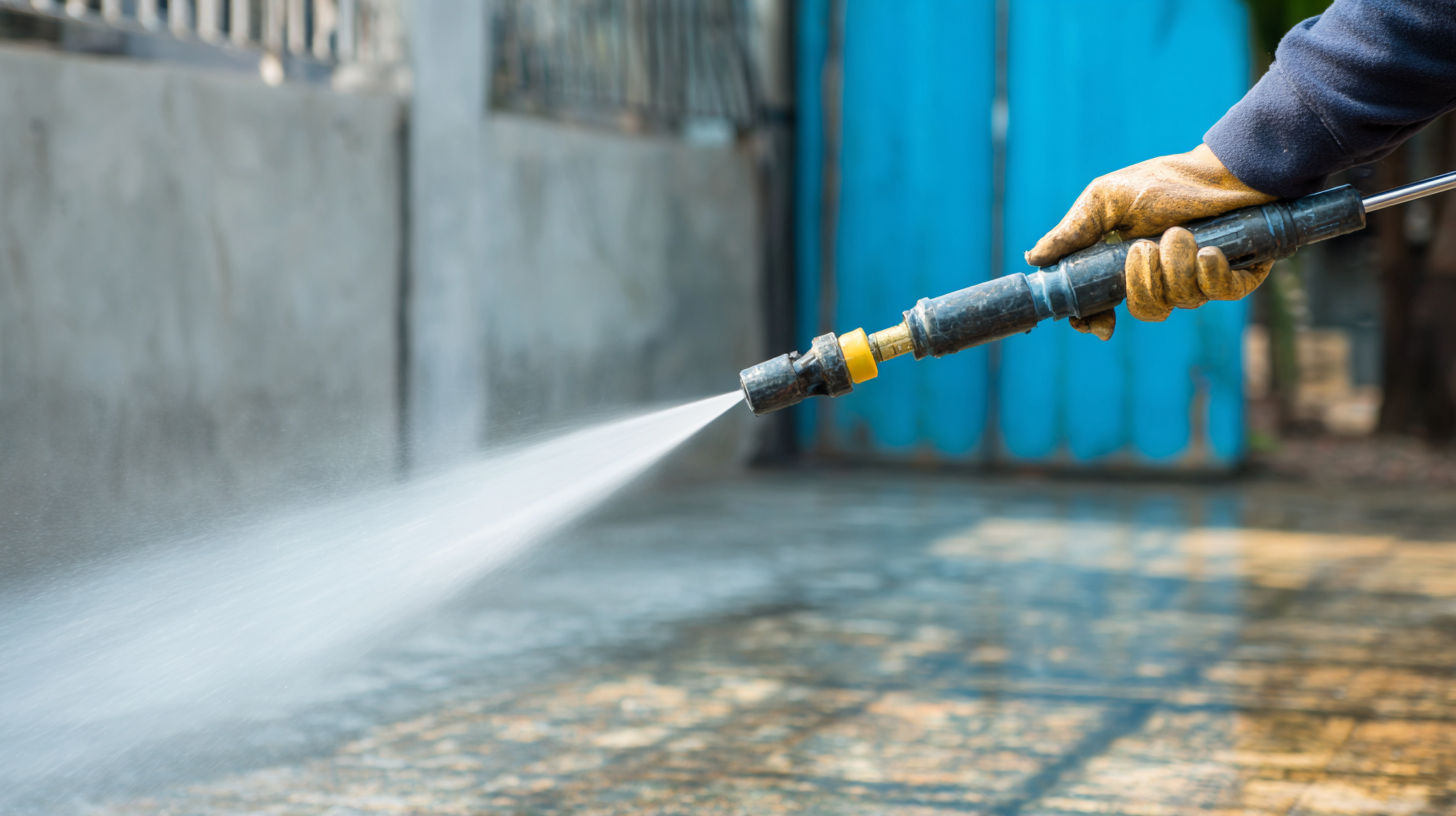How to Choose the Right Pressure Washing Equipment for Your Needs
Choosing the right pressure washing equipment is crucial for achieving optimal results in your cleaning tasks, whether you're a homeowner looking to spruce up your driveway or a professional seeking reliable tools for your business. With a variety of models, sizes, and features available in the market, it can be overwhelming to navigate the options and select the best one that fits your specific needs. Understanding the types of pressure washing equipment, including electric versus gas-powered models, the appropriate pressure levels for different surfaces, and additional attachments that can enhance functionality, is essential for making an informed decision. This guide aims to simplify the selection process, helping you consider key factors such as price, efficiency, and durability, so you can invest in the right equipment to tackle your cleaning projects effectively and efficiently.

Identify Your Pressure Washing Needs and Goals
When selecting pressure washing equipment, it’s essential to identify your specific needs and goals. Different tasks require different levels of pressure and flow rates; for instance, light-duty cleaning, such as washing cars or garden furniture, may only need a lower PSI (pounds per square inch) model. In contrast, heavy-duty jobs like stripping paint or cleaning concrete surfaces demand machines with higher PSI and GPM (gallons per minute) ratings. Assessing the nature of your cleaning tasks will help you determine the right equipment.
Tips: Start by listing the surfaces you plan to clean and the types of grime or stains you expect to encounter. This will provide a clearer understanding of the pressure, nozzle, and attachments needed for efficient cleaning. Additionally, consider whether you prefer electric or gas-powered machines, as this choice can impact mobility and cleaning power.
Think about your long-term goals as well; if you plan to use the pressure washer for a variety of projects or commercial purposes, investing in versatile equipment with adjustable settings may be worthwhile. Look for features like interchangeable nozzles or detergent tanks to enhance your cleaning capabilities. Your needs today may evolve, so choosing adaptable equipment can save both time and money in the future.
How to Choose the Right Pressure Washing Equipment for Your Needs
| Equipment Type | Pressure (PSI) | Flow Rate (GPM) | Suitable for | Approximate Price |
|---|---|---|---|---|
| Electric Pressure Washer | 1300 - 2000 PSI | 1.2 - 2.0 GPM | Home & Car Cleaning | $100 - $300 |
| Gas Pressure Washer | 2500 - 3000 PSI | 2.3 - 3.5 GPM | Heavy-Duty Outdoor Cleaning | $300 - $600 |
| Commercial Pressure Washer | 3000 - 4000 PSI | 3.0 - 5.0 GPM | Professional Cleaning | $600 - $1500 |
| Hot Water Pressure Washer | 2000 - 3000 PSI | 2.5 - 4.0 GPM | Grease and Oil Removal | $800 - $2500 |
Understand the Different Types of Pressure Washers
 When selecting pressure washing equipment, understanding the different types of pressure washers is crucial for effectively meeting your cleaning needs. There are three primary categories: electric, gas, and battery-powered pressure washers.
Electric pressure washers are ideal for light to medium tasks such as washing cars, patios, and garden furniture. They are quieter, easier to maintain, and often more affordable, making them a popular choice for homeowners.
When selecting pressure washing equipment, understanding the different types of pressure washers is crucial for effectively meeting your cleaning needs. There are three primary categories: electric, gas, and battery-powered pressure washers.
Electric pressure washers are ideal for light to medium tasks such as washing cars, patios, and garden furniture. They are quieter, easier to maintain, and often more affordable, making them a popular choice for homeowners.
On the other hand, gas pressure washers are more powerful and suited for heavy-duty jobs, including removing grime from concrete surfaces or stripping paint. If you have larger areas or tougher surfaces to clean, a gas model may be the better choice. Battery-powered pressure washers offer the convenience of portability and are perfect for light tasks where mobility is essential, such as cleaning outdoor furniture away from power outlets.
Tips: When choosing a pressure washer, consider the PSI (pounds per square inch) and GPM (gallons per minute) that best suit your cleaning projects. A higher PSI means more cleaning power, while a higher GPM ensures quicker cleaning. Additionally, think about the accessories you might need, such as different nozzles or surface cleaners, to expand the versatility of your pressure washer.
Evaluate Essential Features for Optimal Performance
When selecting pressure washing equipment, evaluating essential features is crucial for achieving optimal performance tailored to your specific needs. One of the key factors to consider is the pressure rating, measured in pounds per square inch (PSI). According to a report by the Power Washers of North America, for residential cleaning, a PSI range of 1300 to 2300 is ideal, providing enough power to remove dirt and grime without damaging surfaces. By contrast, commercial applications may require units with pressures exceeding 3000 PSI to handle more demanding tasks effectively.
In addition to PSI, the flow rate, measured in gallons per minute (GPM), is also a significant parameter. The same industry report indicates that higher GPM rates can enhance cleaning efficiency by delivering water more rapidly, resulting in quicker job completion. A combination of at least 2.5 GPM with optimal PSI ensures that your pressure washer can tackle a variety of tasks, from washing driveways to cleaning siding. Furthermore, features like adjustable nozzles and detergents compatibility can substantially increase versatility, allowing users to customize their cleaning approach based on the surface type. Therefore, carefully analyzing these essential features will ensure you choose pressure washing equipment that meets your performance expectations, ultimately leading to effective and efficient cleaning outcomes.
Compare Electric vs. Gas Pressure Washers
When choosing pressure washing equipment, one of the key decisions revolves around whether to opt for an electric or gas pressure washer. Electric pressure washers are generally quieter and easier to operate, making them suitable for light to moderate cleaning tasks such as washing cars, patios, and decks. They are ideal for residential users who maintain smaller outdoor spaces and appreciate the convenience of a plug-and-play setup. However, their power is limited, typically ranging from 1,300 to 2,000 PSI, which may not be sufficient for tougher jobs.
On the other hand, gas pressure washers offer greater power and mobility, making them the go-to choice for heavy-duty cleaning tasks. Ranging from 2,000 to over 4,000 PSI, they can tackle larger stains and more extensive areas, such as driveways and building exteriors. However, they require more maintenance, including fuel management and regular oil changes.
**Tips:** When deciding between electric and gas, consider the size of the area you will be cleaning and the types of stains you will encounter. For frequent use in larger areas, a gas pressure washer may be worthwhile. Conversely, if your needs are occasional and less demanding, an electric model suffices and offers lower operating costs. Always check the specifications and reviews before making your final choice to ensure you have the right tool for your specific needs.

Consider Budget and Maintenance Requirements
When considering pressure washing equipment, understanding your budget and maintenance requirements is crucial. The maintenance market is projected to grow significantly, with the global market estimated to reach $13.65 billion by 2025, demonstrating the increasing importance of proper equipment upkeep. Choosing equipment that is both efficient and cost-effective not only ensures longevity but can also align with current economic trends that prioritize budget management.
Moreover, with maintenance costs on the rise and many organizations, including the military, shifting focus toward more affordable alternatives like virtual training, it's essential to factor in ongoing costs when selecting pressure washing equipment. Opting for models that require less frequent service or incorporate user-friendly features can significantly reduce overall expenses. Aligning your equipment choice with these considerations will help maximize the effectiveness of your investment while staying within budget constraints.
Pressure Washing Equipment Cost vs. Maintenance Frequency
This chart compares the cost of different types of pressure washing equipment with their average maintenance frequency per year. Choosing the right equipment requires understanding both the financial investment and the upkeep needed to keep it running efficiently.